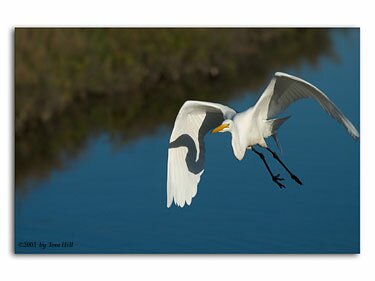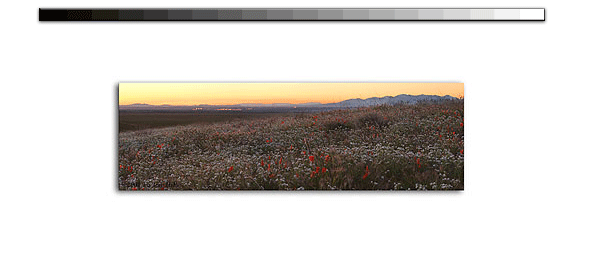|
|
|

|
|
|
|
Great Egret In-Flight, Bolsa Chica NP - Nikon D1h, 70-200 f/2.8 AF-S VR, TC-14e
|
|
|
Before we just run out and throw away our Nikon cameras because their serious lack of technology improvement, lets consider how often this happens. First, any nature photographer worth his salt uses a tripod predominately for all his imagery. Even though you can use IS technology, lots of very accomplished photographers still wont give up their tripods to stabilize their cameras. It just makes sense them to keep their gear steady on a tripod instead of using their hands or less steady monopods. In fact, until recently, Canons IS technology tended to act a bit flakey when it was perched upon a tripod. The movement was too little for the IS sensors to work with. As a result, the IS sensors tended to make their own movement thus making the situation worse than it was. Fortunately for the technology pundits, Canon fixed this with the most current IS lens system. Another fix whether you had the latest technology or not was to simply disable IS which would therefore render your lens as technology advanced as any Nikon. If I have IS off so often on a tripod, why do I need that IS technology? Well, thats the whole point for many Nikon shooters. Before you take this argument as nothing but sour grapes of Nikons faithful let me really say how often do you need IS regardless of its utility on a tripod? In my experience, Ive been able to capture awesome low light images under same or similar conditions as my Canon brethren. Its all about technique. With a superior technique, you can make low light, low speed environmental photos with relative ease. Im not saying you can do this all the time, but to say technology is the only way to take slow speed, static subject pictures is flat out wrong. You can do this everyday without the superior technology. In fact, if youre into taking action images that need action stopping shutter speeds, the argument for IS/VR becomes less of an issue. For most circumstances, you dont have to use IS/VR to make amazing images.
I can only think of two scenarios exclusively the domain of IS/VR. First, is using stacked tele-converters. This is where youre using both a 1.4x and 2.0x tele-converter on your super long lens. A 600mm becomes 1680mms with this combo. No question, sharp images without IS/VR would be practically impossible/lucky. Technique cant solve this challenge even using the best, strongest tripod money can buy. Secondly, if youre shooting from a boat or moving platform at low light once again you need IS/VR. Basic lenses just wont help in these cases.
Now that youve read this, consider when was the last time you wanted to shoot from a boat? How often did you need to shoot with stacked tele-converters? While the latter happens more often to me than the former, they both represent a tiny fraction of the shooting scenarios I encounter day to day. Do they merit the thousands of dollars required to change an entire camera system? Not in my book, at least not yet.
Lets look at the other technology improvement; the full-framed, 35mm format digital camera. Canon introduced this amazing camerathe 1Dsjust months ago. Prices were well into the $8,000 dollar range. Unquestionably, the dollar figure would represent the second most expensive item if it ever entered my camera bag. Even then, the1Ds is not without fault, speed being the greatest detractor. For comparative purposes, lots of reviewers claim the 1Ds image quality exceeds that of medium format film. Format 6x7 format cameras are a thing of the past with the introduction of this camera. Of course, in our film days, we all knew 6x7120 filmexceeded 35mm capabilities. I dont think anyone will argue larger imager/sensors will generally produce better pictures. 1Ds files won the resolution wars with the older digital cameras even before it hit the streets. It just made sense. So, comparing the 1Ds to the other, smaller sensor cameras would be like verifying 645 format images was going to be better than 35mm. Its an open and shut case and its a comparison no one should make. The 1Ds and its larger sensor is in a different league than the D1x. Essentially, the 1Ds is the digital equivilant of a medium format camera. If Canon had introduced a camera with a sensor and feature set similar to the Nikons, then thatd be a comparison worth making. As it is, the Canon 1Ds and D1x are two totally different cameras in two different leagues.
Is Nikon making a huge mistake by not competing with Canon in the medium format league of digital photography? Now, thats a worthy question Ill explore here. Remember, 35mm was popularized in the 1930s because of its good image capabilities, flexibility, lower cost lenses, and compact size. The D1x meets all those needs today. The smaller sensor allows D1 series users to get away with shorter focal lengths lenses that weigh less and are less costly. Its a boon to long lens photographers like sport and nature shooters. Photojournalists dont have to schlep along super huge medium telephoto fast lenses. Instead, they only have to use much smaller, lighter, and cheaper short telephoto lenses to meet the same needs as when they shot 35mm film. While a larger sensor would give them more image flexibility with respect to cropping, the same logic would be applicable on the merits of 645 format cameras over 35mm. A full format digital sensor is simply not needed to match the imagery of 35mm film/slides. The D1 series meets those needs today. Anything more would exceed 35mm capabilities, which is the case with Canons 1Ds. If Nikons strategy was only to win the hearts and minds of 35mm users then a full format sensor would exceed those requirements and become a waste.
|
|
|
|

|
Previous Page
|
|
Next Page
|
|

|
|
|
|
|
|
|
|
|
|
|
|
|
|
|
|
 |




